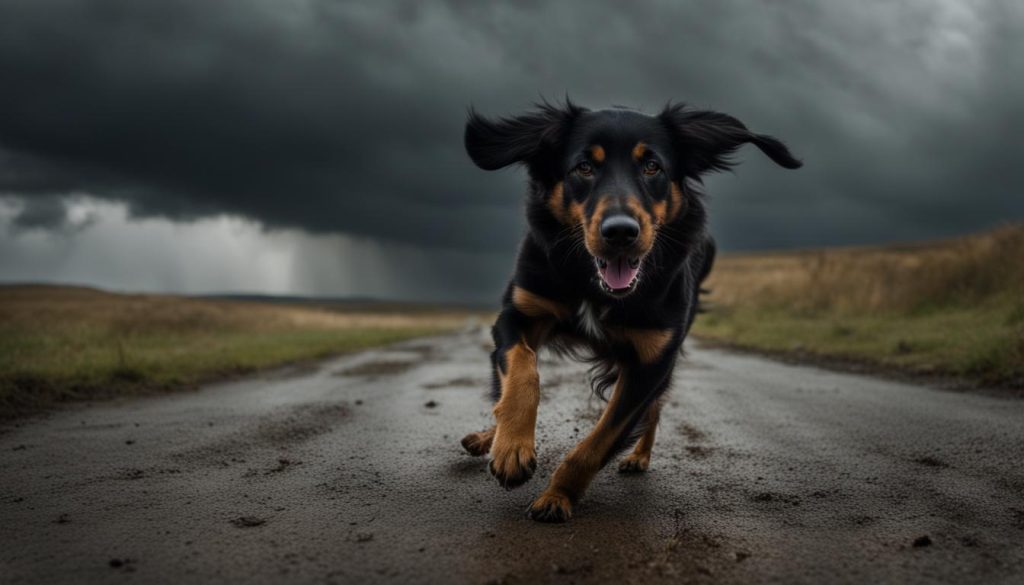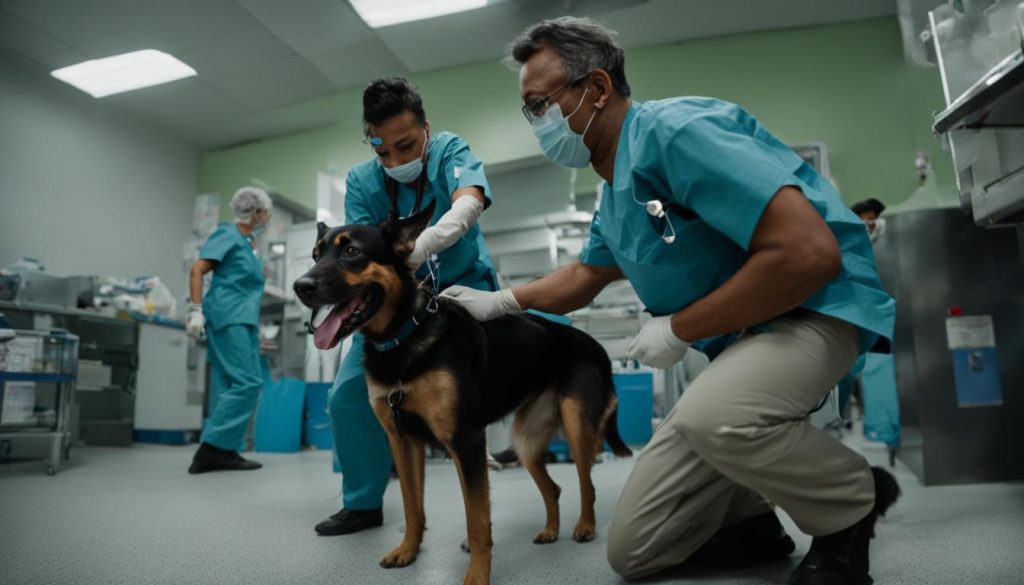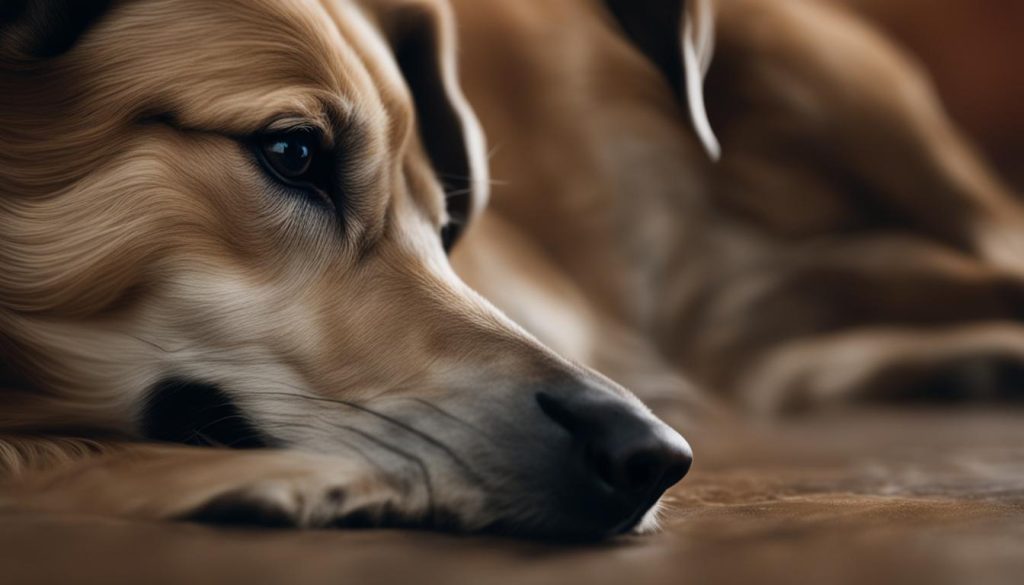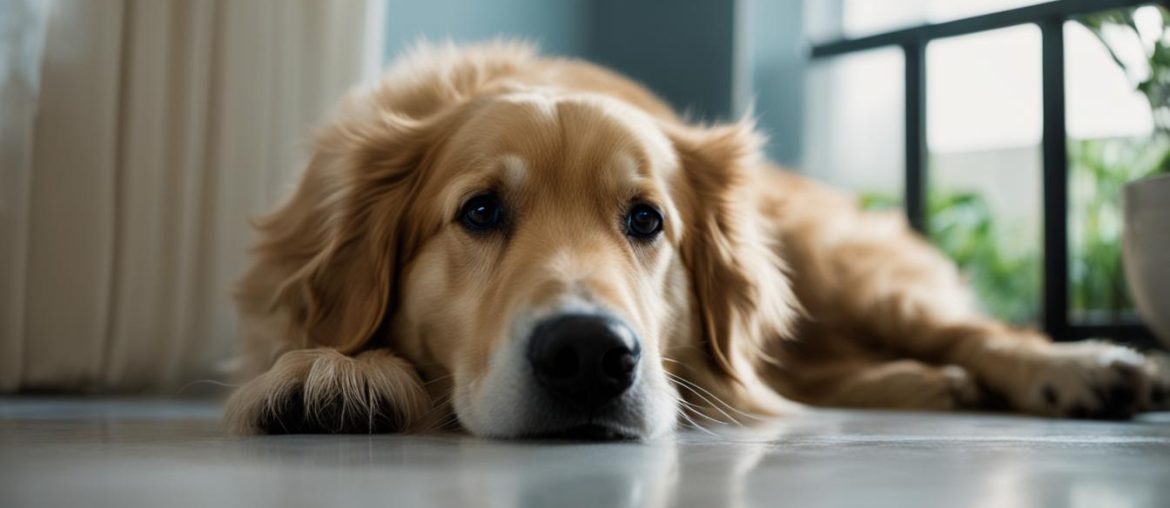Dog bloat, also known as gastric dilation volvulus, is a serious and life-threatening condition that can affect dogs. It occurs when a dog’s stomach fills with gas or food, causing it to twist and block off the blood supply. Understanding the symptoms, causes, and treatment options for bloat is crucial for pet owners to ensure the well-being of their furry friends.
Dogs with bloat may experience various symptoms, including a distended stomach, dry heaving, abdominal pain, difficulty breathing, restlessness, and a rapid heart rate. Early intervention is essential as bloat can be fatal if left untreated. Recognizing the signs and seeking immediate veterinary attention is crucial for saving a dog’s life.
But what about water intake for dogs with bloat? It is generally recommended to withhold food and water from a dog with suspected bloat. Giving water to a dog with bloat may exacerbate the condition by increasing the risk of gastric dilatation and interfering with the veterinarian’s ability to treat the dog effectively.
During emergency treatment for bloat, the veterinarian may need to decompress the dog’s stomach by releasing the gas and fluid buildup. They may also need to surgically untwist the stomach and potentially remove any damaged tissue. Water intake will be carefully monitored during this process.
Key Takeaways:
- Bloat in dogs is a serious and life-threatening condition that requires immediate veterinary attention.
- Common symptoms of bloat in dogs include a distended stomach, dry heaving, abdominal pain, difficulty breathing, restlessness, and a rapid heart rate.
- Water should generally be withheld from a dog with suspected bloat to avoid worsening the condition.
- Emergency treatment for bloat may involve decompressing the stomach and surgically untwisting it.
- Early intervention is crucial for the successful treatment and recovery of dogs with bloat.
Causes of Dog Bloat

Bloat in dogs, also known as gastric dilation volvulus, can have several causes. One common cause is swallowing air, which can occur when a dog eats too quickly or exercises vigorously right after a meal. Certain breeds are also more prone to bloat, such as large and giant breeds like Great Danes and Saint Bernards. The size and deep chest of these breeds make them more susceptible to the condition.
Feeding schedule and diet can also play a role in the development of bloat. Dogs that are fed irregularly or consume rich, high-fat foods may be at higher risk. Additionally, older dogs are more prone to bloat, possibly due to the weakening of ligaments and muscles around the stomach. Lastly, stress can contribute to the development of bloat in dogs, so it’s important to keep their environment as calm and stress-free as possible.
To summarize, the causes of dog bloat can include swallowing air, certain breeds being more prone to it, feeding schedule and diet, age, and stress. Recognizing these causes can help pet owners take preventive measures to reduce the risk of bloat in their dogs.
Table: Breeds Prone to Bloat
| Breed | Size | Predisposition to Bloat |
|---|---|---|
| Great Dane | Large | High |
| St. Bernard | Large | High |
| Irish Wolfhound | Large | Moderate |
| Weimaraner | Large | Moderate |
| Standard Poodle | Large | Moderate |
Table source: Adapted from the American Kennel Club (AKC)
Signs of Bloat in Dogs

Bloat in dogs is a serious condition that requires immediate attention. Recognizing the signs of bloat is crucial for early intervention and potentially saving a dog’s life. Some common signs to look out for include:
- A visibly distended stomach: This can be one of the most noticeable signs of bloat in dogs. However, a distended stomach can also indicate other conditions, so it should not be the sole indicator of bloat.
- Dry heaving or retching: Dogs with bloat may attempt to vomit or gag, but nothing comes up.
- Abdominal pain: Dogs with bloat may experience discomfort or pain in their abdominal area.
- Difficulty breathing: Bloating can put pressure on a dog’s diaphragm, making it difficult for them to breathe normally.
- Restlessness: Dogs with bloat may exhibit restlessness, pacing, drooling, or panting.
- Rapid heart rate: Bloating can cause an increased heart rate in dogs.
If you notice any of these signs in your dog, it’s important to seek immediate veterinary attention. Bloat is a time-sensitive emergency, and prompt intervention can significantly increase the chances of a positive outcome.
“Recognizing the signs of bloat in dogs is crucial for prompt intervention.”
Table: Signs of Bloat in Dogs
| Signs | Description |
|---|---|
| Visibly distended stomach | A noticeable enlargement of the abdomen, although it can indicate other conditions as well. |
| Dry heaving or retching | Attempts to vomit or gag without producing anything. |
| Abdominal pain | The dog may exhibit signs of discomfort or pain in the abdominal area. |
| Difficulty breathing | Bloating can put pressure on the diaphragm, making it challenging for the dog to breathe normally. |
| Restlessness | Pacing, drooling, or panting may be observed in dogs with bloat. |
| Rapid heart rate | Bloating can cause an increased heart rate in dogs. |
Can a Dog with Bloat Poop?

One common question pet owners have is whether a dog with bloat can still have normal bowel movements. Generally, a dog with bloat will not be able to have regular bowel movements. However, in some cases, they may pass small volumes of diarrhea. It is important to note that the presence or absence of bowel movements should not be used as the sole indicator of bloat in dogs. Other symptoms and signs, such as a distended stomach, dry heaving, abdominal pain, difficulty breathing, and restlessness, should also be considered. If there is any suspicion of bloat, immediate veterinary attention is necessary to ensure proper diagnosis and treatment.
| Signs of Bloat in Dogs | Can a Dog with Bloat Poop? |
|---|---|
| Distended stomach | No, or small volumes of diarrhea |
| Dry heaving | |
| Abdominal pain | |
| Difficulty breathing | |
| Restlessness | |
| Rapid heart rate |
A dog with bloat may not be able to have normal bowel movements, and the presence of diarrhea should not be used as the sole indicator of bloat. It is important to consider other symptoms and signs and seek immediate veterinary attention if there is any suspicion of bloat.
Bloat in dogs is a serious and life-threatening condition that requires prompt veterinary attention. Delaying treatment can lead to complications and a higher risk of mortality. If you notice any signs of bloat in your dog, it is crucial to contact your veterinarian immediately for proper evaluation and care. Remember, early intervention is key to improving the chances of a successful outcome.
*Disclaimer: The information provided in this article is for educational purposes only and does not constitute veterinary advice. If your dog is experiencing bloat or any other health concerns, please consult with a qualified veterinarian for proper diagnosis and treatment.*
How to Prevent Bloating in Dogs

Bloating in dogs can be a serious and life-threatening condition, but there are measures that pet owners can take to reduce the risk. By making some simple changes to the dog’s feeding routine, exercise schedule, and monitoring their water intake, it is possible to help prevent bloating episodes.
Feeding Changes
Feeding changes can have a significant impact on preventing bloat in dogs. It is recommended to feed dogs in a calm and relaxed environment, free from distractions and stressors. Using slow-feeding bowls or puzzle feeders can help slow down eating and reduce the likelihood of gulping air while consuming food. Additionally, providing a well-balanced diet that is appropriate for the dog’s age, breed, and specific dietary needs can also contribute to reducing the risk of bloating.
Exercise Scheduling
Timing exercise sessions is important to avoid excessive stretching of the stomach, which can increase the risk of bloating. It is recommended to schedule exercise at least one to two hours after meals. This allows for proper digestion and prevents the stomach from becoming overly distended during physical activity. Moderate exercise is beneficial for dogs, but it is important to strike a balance and avoid intense activity immediately after eating.
Monitoring Water Intake
Monitoring water intake is crucial in preventing bloating. Dogs should have access to fresh water at all times, but it is important to ensure that they do not consume excessive amounts too quickly. Providing water in smaller quantities throughout the day can help regulate intake and reduce the risk of bloating. It is also advisable to avoid allowing dogs to drink large amounts of water immediately before or after exercise, as this can contribute to stomach distention.
By implementing these preventative measures, pet owners can help reduce the risk of bloating in their dogs. However, it is important to note that no preventive measure is foolproof, and immediate veterinary attention should be sought if any signs of bloating are observed.
Emergency Treatment for Bloat in Dogs

When it comes to bloat in dogs, time is of the essence. Immediate veterinary intervention is crucial for the successful treatment of this life-threatening condition. If bloat is suspected, it is imperative to take your dog to a veterinarian as soon as possible. Prompt action can significantly increase the chances of survival.
The emergency treatment for bloat in dogs often involves surgery. The veterinarian will untwist the stomach and restore the blood supply, relieving the pressure and preventing further complications. This surgical procedure is known as gastropexy. In some cases, the veterinarian may need to remove any damaged tissue.
It is important to note that bloat surgery carries certain risks, and the outcome depends on the severity of the condition and the timeliness of the intervention. The success rate is generally high when the surgery is performed promptly. However, delays in seeking veterinary care can significantly reduce the chances of a positive outcome. Therefore, it is crucial not to hesitate when it comes to seeking emergency veterinary care for your dog if you suspect bloat.
| Emergency Treatment for Bloat in Dogs | Benefits | Risks |
|---|---|---|
| Immediate veterinary intervention | Increased chances of survival | None identified |
| Surgical intervention | Untwisting the stomach to restore blood supply | Risks associated with general anesthesia and surgery |
Quote:
“If your dog is experiencing bloat, it is essential to act swiftly. Immediate veterinary intervention, including surgery if necessary, can make a lifesaving difference. Every minute counts when it comes to treating bloat in dogs.”
Real-Life Example of Bloat in Dogs

In the movie “Marley & Me,” a real-life example of a dog experiencing bloat is depicted. Bloat, also known as gastric dilation volvulus, is a serious health concern that can quickly lead to a pet’s death if not treated in time. This condition can be distressing for both the dog and its owner, and it often requires immediate veterinary intervention. The cost of treatment for bloat can be significant, with surgical and medical expenses adding up to thousands of dollars. Prompt veterinary care and insurance coverage were crucial in the successful treatment and recovery of the dog in the real-life example.
It’s important for pet owners to be aware of the signs and symptoms of bloat in order to seek prompt medical attention. Early intervention is key to improving the chances of a positive outcome. If you notice any unusual behavior or physical changes in your dog, such as a distended abdomen, restlessness, or difficulty breathing, it’s important to consult a veterinarian immediately.
When it comes to the treatment of bloat, time is of the essence. The longer the condition goes untreated, the greater the risk to the dog’s health and well-being. Veterinary care for bloat typically involves intravenous fluids, pain medication, and, in some cases, emergency surgery. The cost of treatment can vary depending on the severity of the condition and the specific needs of the dog. Pet insurance can help alleviate the financial burden, but it’s important for pet owners to be prepared for the potential costs associated with treating bloat.
Expert Veterinary Advice on Bloat Treatment
When it comes to treating bloat in dogs, early intervention is crucial. I have seen many cases where catching bloat early and seeking immediate veterinary care have made a significant difference in the outcome. Surgery is often necessary to correct the condition, and the timing of the surgery plays a vital role in the dog’s survival. In fact, the survival rate for dogs undergoing timely surgical treatment for bloat is high, with approximately 95% of animals coming through it successfully.
As a veterinarian with years of experience in treating bloat, I cannot stress enough the importance of recognizing the signs and seeking prompt veterinary attention. If you notice your dog exhibiting symptoms such as a distended stomach, dry heaving, abdominal pain, difficulty breathing, restlessness, or a rapid heart rate, it is crucial to contact your veterinarian immediately. Time is of the essence when it comes to bloat, and early intervention can save your dog’s life.
“Early intervention is key when it comes to treating bloat in dogs. Surgery is often necessary, and timing is crucial.”
While surgery is the primary treatment for bloat, the recovery process can vary depending on the individual dog and the severity of the condition. After surgery, your dog may require intravenous fluids, pain medication, and careful monitoring. The duration of hospitalization and post-operative care will depend on your dog’s specific needs.
| Survival Rate for Bloat Surgery | Surgical Treatment for Bloat |
|---|---|
| Approximately 95%* | Untwisting the stomach and removing damaged tissue, and in some cases, performing a gastropexy to prevent future episodes of bloat |
*Disclaimer: The survival rate may vary depending on the individual dog’s condition, overall health, and the timeliness of surgical intervention.
As with any medical condition, it is always best to consult with your veterinarian to determine the most appropriate treatment plan for your dog. They will be able to provide expert advice based on your dog’s specific needs and circumstances.
Causes and Risk Factors of Bloat in Dogs
There are several possible causes and risk factors that can contribute to bloat in dogs. Understanding these factors can help pet owners take preventive measures and reduce the chances of their dogs experiencing this life-threatening condition.
Exercising after eating is a known risk factor for bloat. When dogs engage in vigorous activity immediately after a meal, it can lead to excessive stretching of the stomach, making it more prone to bloating. Gulping air while eating too rapidly is another factor that can increase the likelihood of bloat. Dogs that eat their food too quickly may swallow air along with their meal, leading to stomach distension.
Dietary factors such as consuming dry food followed by excessive water intake can also contribute to bloat. Dry food can expand in the stomach, while excess water can further dilate it, putting the dog at greater risk. Stress and anxiety have also been identified as potential risk factors for bloat. Dogs experiencing high levels of stress or anxiety may be more susceptible to developing this condition. Additionally, certain neurological disorders may increase the likelihood of bloat in dogs.
Table: Risk Factors for Bloat in Dogs
| Risk Factors | Description |
|---|---|
| Exercising after eating | Vigorous physical activity immediately after a meal can lead to excessive stretching of the stomach. |
| Gulping air | Dogs that eat their food too quickly may swallow air, increasing the risk of bloat. |
| Dry food and excess water | Consuming dry food followed by excessive water intake can contribute to stomach distension. |
| Stress | High levels of stress or anxiety may make dogs more susceptible to bloat. |
| Neurological disorders | Some neurological disorders may increase the likelihood of bloat in dogs. |
By being aware of these causes and risk factors, pet owners can take proactive steps to minimize the chances of their dogs developing bloat. It is important to consult with a veterinarian for guidance on preventive measures specific to individual dogs, particularly those breeds that are genetically predisposed to this condition.
Tips for Avoiding Bloat in Dogs
Preventing bloat in dogs requires proactive measures and careful attention to their daily routines. Here are some tips to help you reduce the risk of bloat and ensure the well-being of your furry friend:
1. Monitoring Food Intake
Keep a close eye on your dog’s food intake to prevent overeating, which can contribute to bloat. Avoid free-feeding and establish regular meal times. Measure their food portions according to their breed, size, and age. Consult with your veterinarian to determine the appropriate feeding schedule for your dog.
2. Elevated Food Bowls
Elevated food bowls can help dogs maintain a more natural posture while eating and drinking. This can reduce the amount of air they swallow, decreasing the risk of bloating. Consider using elevated bowls that are at an appropriate height for your dog’s size and breed.
3. Timing of Exercise
Avoid vigorous exercise or intense activity immediately before or after meals. Engaging in strenuous physical activity on a full stomach can increase the chances of bloat. Give your dog time to digest their food properly before engaging in exercise. Waiting at least one to two hours after meals is recommended.
4. Moderate Water Intake
While it’s essential for dogs to stay hydrated, excessive water intake can contribute to bloat. Encourage moderate water consumption by providing fresh water throughout the day and avoiding large amounts of water before and after exercise. Make sure your dog drinks water calmly and does not gulp it down excessively.
5. Consider Preventive Surgery
If your dog is at a higher risk of developing bloat due to their breed or previous history, consult with your veterinarian about preventive surgery. A procedure called gastropexy can be performed to secure the stomach to the abdominal wall, reducing the chances of twisting and the occurrence of bloat.
By implementing these tips, you can help reduce the risk of bloat in your dog. Remember to consult with your veterinarian for personalized advice and guidance based on your dog’s specific needs and circumstances.
Treatment and Recovery for Bloat in Dogs
When it comes to the treatment and recovery of bloat in dogs, immediate veterinary intervention is crucial. The severity of the condition will determine the course of action, but there are several common approaches that may be taken.
Intravenous fluids are often administered to dogs with bloat to help stabilize their condition and prevent dehydration. This involves the use of a catheter to deliver fluids directly into the bloodstream, ensuring that the dog’s body receives the necessary hydration. Pain medication may also be administered to alleviate discomfort and help the dog rest during the recovery process.
In some cases, decompressing the stomach may be necessary. This can be done by passing a tube through the dog’s mouth or nose, down into the stomach, to release trapped gas and alleviate pressure. Decompression can provide immediate relief and help prepare the dog for surgical intervention, if required.
Surgery is often the primary course of action for dogs with bloat, particularly those with gastric dilatation volvulus (GDV) where the stomach twists. The surgical procedure involves untwisting the stomach and spleen, removing any damaged tissue, and assessing the overall health of the organs. In some cases, a gastropexy may also be performed, where the stomach is attached to the body wall to prevent future episodes of bloat.
| Treatment | Recovery |
|---|---|
| Intravenous fluids | Recovery time varies depending on the individual dog and the severity of the condition. |
| Pain medication | Close monitoring by a veterinarian is necessary to ensure a successful recovery. |
| Decompressing the stomach | Dogs may require a period of rest and limited activity following surgery. |
| Surgery | Proper post-operative care and adherence to veterinary instructions are essential for a smooth recovery. |
| Gastropexy | A follow-up visit to the veterinarian is typically required to assess the dog’s progress and address any concerns. |
The recovery time for dogs with bloat can vary depending on the individual dog and the severity of the condition. Close monitoring by a veterinarian is necessary to ensure a successful recovery, and dogs may require a period of rest and limited activity following surgery. Proper post-operative care and adherence to veterinary instructions are essential for a smooth recovery. A follow-up visit to the veterinarian is typically required to assess the dog’s progress and address any concerns that may arise during the recovery period.
Wrapping Up
In conclusion, bloat in dogs is a serious and potentially life-threatening condition that requires immediate veterinary attention. Understanding the causes, signs, and preventive measures is crucial for pet owners to protect their beloved canine companions.
Early intervention is key to improving the chances of a successful outcome. Seeking prompt veterinary care and treatment can save a dog’s life. It is important to be aware of the signs of bloat, such as a distended stomach, dry heaving, abdominal pain, difficulty breathing, restlessness, and a rapid heart rate.
Prevention plays a vital role in reducing the risk of bloat in dogs. Monitoring food intake, scheduling exercise sessions appropriately, and regulating water intake can help minimize the chances of bloat occurring. Regular veterinary check-ups and open discussions with a veterinarian can provide further guidance on preventing and managing this condition.
In conclusion, being proactive and educated about bloat in dogs can make a significant difference in saving a pet’s life. By taking preventive measures and recognizing the signs early on, pet owners can help ensure the well-being and longevity of their furry friends.
FAQ
Will a dog with bloat drink water?
No, a dog with bloat will typically not drink water. It is important to seek immediate veterinary attention if you suspect your dog has bloat.
What are the causes of dog bloat?
The exact causes of dog bloat are not fully understood, but risk factors include swallowing air, certain breeds being more prone to it, feeding schedule and diet, age, and stress.
What are the signs of bloat in dogs?
Common signs of bloat in dogs include a distended stomach, dry heaving, abdominal pain, difficulty breathing, restlessness, and rapid heart rate.
Can a dog with bloat poop?
Generally, a dog with bloat will not have normal bowel movements. Passing small volumes of diarrhea may occur, but bowel movements are an unreliable indicator of bloat.
How can I prevent bloating in dogs?
Feeding changes, scheduling exercise sessions after meals, monitoring water intake, and consulting with a veterinarian can help prevent bloat in dogs.
What is the emergency treatment for bloat in dogs?
Bloat in dogs is a time-sensitive emergency that requires immediate veterinary intervention. Surgery may be necessary to untwist the stomach and restore blood flow.
Can you provide a real-life example of bloat in dogs?
The movie “Marley & Me” depicts a real-life example of a dog experiencing bloat. Prompt veterinary care and treatment were crucial in the successful recovery of the dog.
What advice do experts give regarding bloat treatment?
Veterinary experts emphasize the importance of early intervention and timely surgical treatment for bloat. The survival rate for dogs undergoing timely surgical treatment is high.
What are the possible causes and risk factors of bloat in dogs?
Possible causes and risk factors of bloat in dogs include exercising after eating, gulping air, certain breeds being more prone to it, and factors such as stress and neurological disorders.
How can I avoid bloat in dogs?
To avoid bloat in dogs, monitor food intake, create a calm feeding environment, schedule exercise sessions appropriately, moderate water intake, and consider preventive surgery for breeds at higher risk.
What is the treatment and recovery process for bloat in dogs?
Treatment for bloat in dogs depends on the severity of the condition and may involve hospitalization, intravenous fluids, pain medication, decompression of the stomach, surgery, and gastropexy. Recovery time varies.
Is bloat in dogs a serious condition?
Yes, bloat in dogs is a serious and potentially life-threatening condition that requires immediate veterinary attention. Understanding the signs, causes, and preventive measures is crucial for pet owners.






